Nandini D
Everyone wishes to be happy and healthy. Gardening is a simple way of achieving both health and happiness. It can be taken up by anyone at any age. Gardening enhances awareness of one’s surroundings, improves cognitive skills and provides an opportunity to appreciate nature, especially since most of us live in urban jungles. While nutrition gardens and eco-clubs are slowly making their way into schools, many are still unaware of the benefits of gardening. Articles in this column will provide information about common plants and their use in daily life. Each article will focus on a set of questions and provide a broader scope for further learning.
On a Sunday morning, I got a phone call from Rina’s mother, Sujatha. She spoke to me about her daughter’s gardening initiatives and expressed a wish to visit my house. I asked her to come along with the children in the afternoon.

Around 3 pm everyone arrived and started discussing about their plants. Sujatha got a bottle of red juice and poured it into a glass jar. I added a little jaggery, lemon juice and a few Salvia flowers to garnish it. The children were excited by the bright red coloured drink.
Rina announced, “This is from my home garden, hibiscus flower juice for you.”
“I will make red colour ice cubes from this,” Vivan declared.
“What are those black coloured trays?” Sujatha asked.
I took one out to show my guests. “These are called root trainers. Each cup has a small hole at the bottom. We can fill cocopeat into these cups to germinate seeds. When the seeds grow into a small plant, we can easily pull out the plant along with the roots and plant it wherever we wish.”
“This is cute, may I try this now?”
“Sure, you can.”
As everyone sat down and placed the tray in the centre, I spread the seeds on a paper.
“Sujatha, now you fill cocopeat in all the cups. Place a seed at the centre and slightly cover with a layer of cocopeat. Sprinkle water over it.”
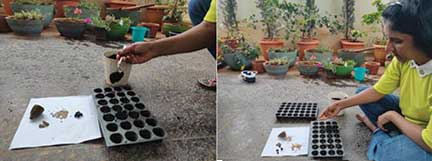
“Aunty, from where did you get these seeds?” Shilpa asked.
“I collect seeds from this garden and sometimes borrow from my friend’s house, whenever I find something interesting. You can get various types of flower and vegetable plant seeds from nurseries and shops too.”
“What is this cocopeat? It is very soft.”
“It is made from coconut husk. It maintains sufficient moisture and aeration. The young plants produce profuse roots in these trays.”
Shilpa said, “If we sow seed in this tray, we can also check which seed germinated and which one did not.”
“Yes, Shilpa, you can see the other tray. I tried to germinate different types of bean seeds. So, I labelled them.”
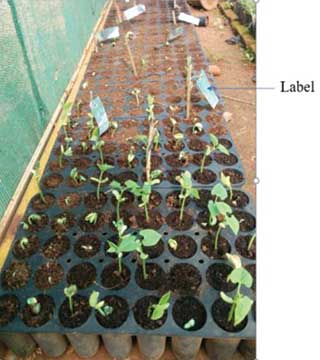
“Your garden looks beautiful and clean. How do you dispose waste?”
“I generally recycle everything. I do compost with leaf litter and kitchen waste. This will turn out to be good manure. Look, these are earthworms.”
“How to do this composting, Nandini?”
“Depending on the quantity of waste available, you must decide on the size of the compost bin. You can use more than one bin too.”
• Keep adding all the wet waste in a bucket or a composting pot. Sprinkle water.
• Keep it covered with a plate.
• Everyday keep adding litter, volume declines due to degradation of cellulose.
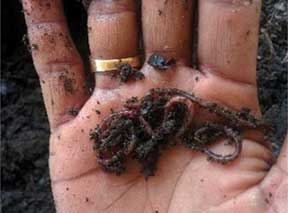
• After 15 days add a little cow dung mixed with water or 3-4 spoons of sour milk. This will enhance the breakdown of all the matter.
• Spread some more digested matter over it and add worms.
• Worms will keep feeding and further breakdown the waste.
• A good dark brown powder like compost you will get after 45-50 days.
Otherwise, you can also buy a composting brick to make compost.
“What precautions should we take?”
“Avoid cooked food waste, meat and egg; these attract ants. Coconut shell or any thick material should not be added either.”
Anand went to the other side, “Wow! great aroma. See, beautiful flowers.”
Sujatha said, “It’s fragrant, the leaves look like turmeric plant. I get turmeric plant leaf to make idli on Ganesh Chaturthi.”
“It is soughandhika pushpa,” Shilpa screamed.
“Great! Let us clap for Shilpa….”
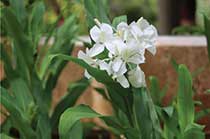
“Sujatha, they all come from the ginger family called Zingiberaceae.”
“Then it is simple, we can grow different types of gingers at home!”
“Yes, you can take a small piece of rhizome to propagate.”
“Nandini, it is all very interesting. How do we get to know about different types of plants and gardens?”
“It is easy, observe the landscape, next time when you go to a park, a temple or a resort. You can notice different thematic areas.”
Shilpa pointed, “I know, Rose Garden in Lalbagh. In one place many different rose plants are planted.
Sujatha continued “I have seen ‘Sanjeevini Vana’ near the Shiva temple in my hometown. Many medicinal plants grow there. Navagraha Vana (Plants for nine celestial elements) is also maintained next to the temple.”
“Come, let’s go inside and see some pictures.” I opened my laptop to show the pictures.
Shilpa said, “Aunty, I know the story of Sanjeevini also. Hanuman could not identify the plant. So, he carried the whole mountain to save Lakshmana.”

“Great! You are well informed. A garden is a place where plants are selectively grown and maintained. There are many examples from history, art and literature to learn about gardens and gardening from different cultures, all over the world. Egyptian tomb paintings of 1500 BC shows the well-designed gardens with water bodies in the centre and trees around the pond. Mayan (250-900 CE) and Aztec Empire (1428-1521 CE) in the South American region had both practical and aesthetic gardening traditions. The Mayans made extensive usage of forest gardens for food and medicinal plants. The Aztec elite built elaborate pleasure gardens in the Valley of Mexico including fountains.”

“Look here, near Rajgir (earlier Rajagruha) we can see ruins of Javak Amaravana where Jivaka’s hospital and garden was situated. Jivaka was known as ‘medicine king’ in the 5th BCE; he treated Lord Buddha and emperor Bimbisara.”
“Selection of grains, fruits and vegetable bearing plants from the wild, growing it near human settlements must have led to the practice of gardening. Over a period, man learnt to multiply and use farming techniques to increase the production.”
Sujatha said, “Two years ago we visited the Ooty Botanical Garden. It is huge and beautiful with different types of flowering plants. I bought some seeds from the nursery there.”
“Oh, you have seen the botanical garden! The Ooty garden has a huge collection of plants both from local and other parts of the world. It was started with the intention of supplying vegetables to residents. Later, more importance was given to aesthetics by adding sculptures and themes.”
“What about Lalbagh garden, aunty? I had been to Lalbagh flower show with my parents. We bought fruits and flowerpots that time,” said Anand.
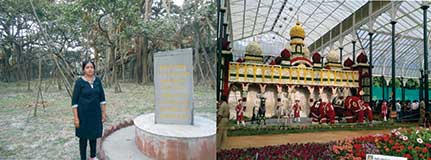
“Hyder Ali, in the 18th century is acknowledged to be the founder of Lalbagh. Then his son Tippu Sultan added many plants to the garden from Kabul, Persia, Mauritius, Turkey and Africa. Later in 1856, Mark Cubbon declared it as a government botanical garden. Here also many crop plants were introduced for experimental cultivation.”
“See, this. A big banyan tree in the Kolkata Botanical Garden”.
“Why are all these gardens called as botanical gardens?”
“The primary objective of a botanical garden is to have a live repository of various forms like trees, climbers, herbs, which show their relationship with each other. Flowers and fruits are seasonal. You know, some plants live only for a short duration. So, in such gardens, scientists get the collection of plants and plant parts and store them with proper labelling. It is important for students and scientists who study plants in a systematic way. These gardens also maintain nurseries to multiply plants.”
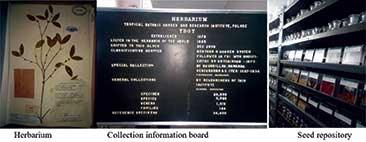
“I was under the impression that gardens are only for decoration and we must spend a lot of money to buy seeds, fertilizers and garden tools. Moreover, we need to spend a lot of time to maintain it, but now I understand it is not very difficult. Some time we must go to see the botanical garden with you, Nandini.”
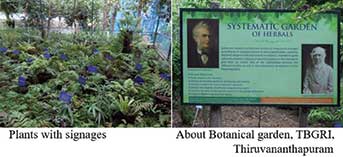
“Sure, we can. You can make a functional garden by understanding the culture and traditions. For example, we all appreciate water lilies and lotus. Lotus is considered auspicious. You can make a small pond and grow them.”
“Wonderful idea. I will also make a pond.”Anand, Vivan, Rina, Shilpa everyone started jumping.
Find the answer!
- Prepare a list of thematic gardens you can make.
- Name different gardens you have seen.
Bibliography
- NM Ganesh Babu, Geetha Suresh and K Haridasan, 2010, Secrets of Ethno Medicinal Gardens, FRLHT, Bangalore
- Nandini D and NM Ganesh Babu 2016, Ere hulu gobbra thayarike, (Kannada), FRLHT, Bengaluru
- https://www.britishmuseum.org/collection/object/Y_EA37983
- https://www.mexicolore.co.uk/aztecs/aztefacts/aztec-pleasure-gardens
- http://blogs.getty.edu/iris/a-field-guide-to-renaissance-gardens/
- https://en.wikipedia.org/wiki/J%C4%ABvaka
- https://en.wikipedia.org/wiki/Government_Botanical_Gardens,_Ooty
- https://archive.org/details/TheLalbaghAHistoryByKVinoda/page/n5/mode/2up
The author is a botanist. She has been involved in teaching and research for more than 25 years. Currently she is working as a Consultant for We Care Society (WCS), Bengaluru and serving as visiting faculty member, RIWATCH, Roing, Arunachal Pradesh. She can be reached at nandinidholepat@gamil.com.
